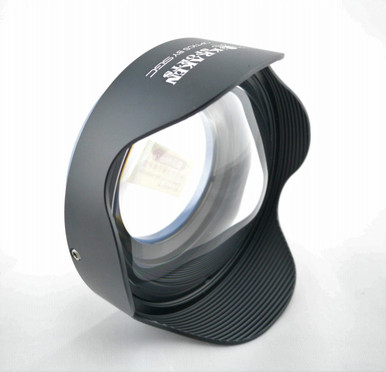Okay, basic primer - when light passes through a water/glass/air boundary at an angle, it refracts - i.e. the rays' path gets bent. When you're shooting a wide-angle lens underwater through a flat port, the image shrinks and suffers from pincushion distortion. Here is a fairly extreme example with a 10mm lens on APS-C (15mm-equivalent) shooting pool tiles through a flat port:
For comparison, here is the same image taken with the same settings, from the same spot, but through a dome port:
The reason dome ports create this effect is that when you place your lens at the geometric center of the dome's sphere, every ray of light that reaches the lens crosses the dome's water/glass/air boundary at exactly the right angle, in which case it does not suffer from refraction. That's the theory anyway - in practice, you can't attain this absolutely perfect positioning, but you can get close enough as to make no matter.
Now, with a compact camera that has a 24mm-equivalent lens (at its widest setting), shooting through a flat port, you will get something like this (taken in a different pool session from the above photos, so not directly comparable):
As you can see, there is moderate distortion, easily visible if you've got straight lines in your photo. Now, if you put on a dome, wet or dry (I was using a dry dome), you will get something like this:
As you can see, the lines are now straight, and field of view is expanded considerably. However, if you equip a true wet lens - Fantasea UWL-09F, in my case - you get a massively expanded field of view, albeit at the cost of fisheye-like barrel distortion:
Now, about Inon UWL-H100 - this is actually a modular lens, the base unit has a flat front element, and gives you a 179-degree diagonal angle of view in air, but only 100.8 degree diagonal angle of view underwater - this is precisely because of the refraction issues that I have outlined above. To expand the underwater angle of view, Inon sells you the optional Dome Lens Unit, which fits on the front, and expands your angle of view underwater to 144.8 degrees - note that it has no effect in air.
One big caveat regarding the Panasonic LX10 specifically: the lens on this camera moves forward and back a lot as it zooms, which causes it to sit fairly deep inside the port when set to its widest setting. This causes significant vignetting with wet wide lenses, see this thread for samples:
The results are in... I finally got into the pool to test these lenses KRL-01 vs UWL-09 Pro
I don't own this camera and never used it, but from what I've seen online, you generally need to zoom it to about 35mm to avoid vignetting. With Inon UWL-H100, this can pose an additional issue: this lens is
not designed as a zoom-through lens, i.e. it is designed to work with a 28mm-equivalent FL lens behind it - nothing more, nothing less. If you try to zoom in, your camera might not be able to focus. This is not something that I have had an opportunity to test, but Inon's compatibility chart does not feature the LX10 at all, so I'd be very wary of that combination.
Note that if you're shooting 4K video on the LX10, it imposes a significant crop, making your widest setting the equivalent of 36mm, and getting rid of this vignetting. 1080P crops you to about 30mm equivalent, so you will still need a touch of zoom.

 www.bluewaterphotostore.com
www.bluewaterphotostore.com




 ! - Merry Christmas
! - Merry Christmas